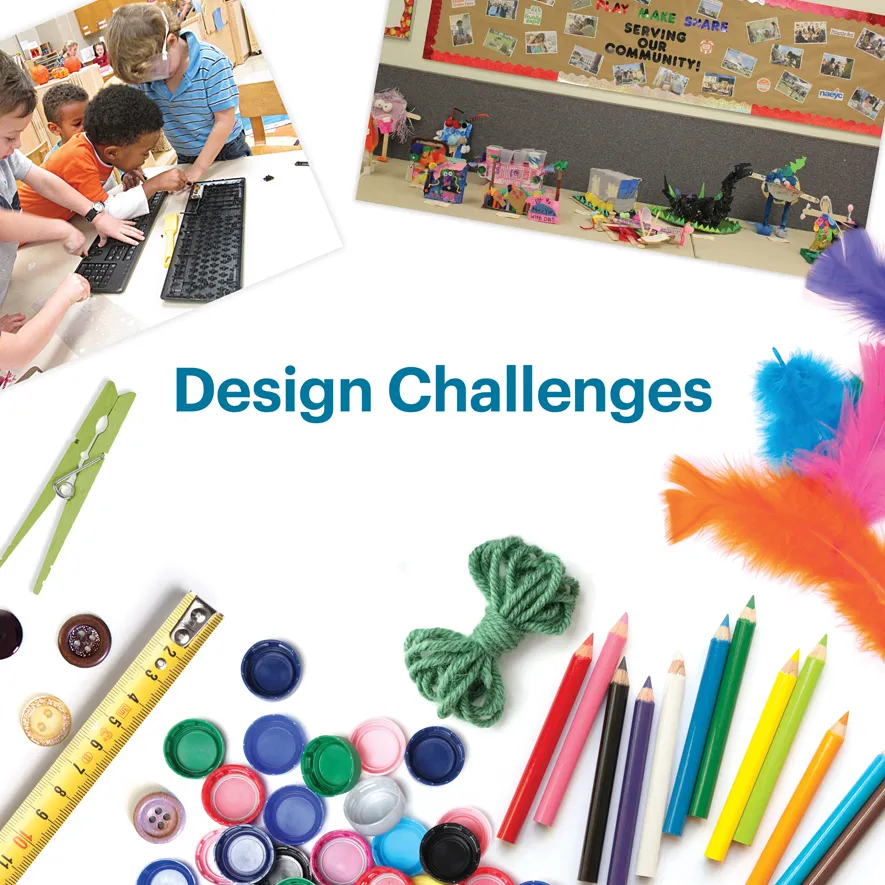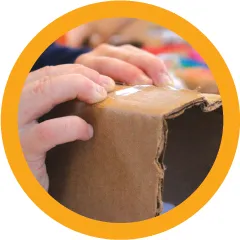
eBook - ePub
Making and Tinkering With STEM
Solving Design Challenges With Young Children
Cate Heroman
This is a test
Condividi libro
- English
- ePUB (disponibile sull'app)
- Disponibile su iOS e Android
eBook - ePub
Making and Tinkering With STEM
Solving Design Challenges With Young Children
Cate Heroman
Dettagli del libro
Anteprima del libro
Indice dei contenuti
Citazioni
Informazioni sul libro
Tinker, make, engineer—solving problems from picture books!
Can you build a sturdy house that is safe from the big, bad wolf?
Imagine your dream car. What special features does it have? What can you use to create it?
Teaching and learning STEM subjects (science, technology, engineering, and mathematics) is more accessible than ever before! Children will be inspired, delighted, and challenged as they use everyday materials and STEM concepts to design and build solutions to problems faced by characters in their favorite books. This practical, hands-on resource includes:
- 25 engineering design challenges appropriate for children ages 3–8
- Suggestions for creating a makerspace environment where children can tinker with materials, use tools to make creations, and improve on their ideas
- A list of 100 picture books that encourage STEM-rich exploration and learning
- Questions and ideas for expanding children's understanding of STEM concepts
- A planning template so you can create your own design challenges
Use engaging children's books together with the guidance and ideas in this book to extend children's problem-solving skills and creative thinking.
Domande frequenti
Come faccio ad annullare l'abbonamento?
È semplicissimo: basta accedere alla sezione Account nelle Impostazioni e cliccare su "Annulla abbonamento". Dopo la cancellazione, l'abbonamento rimarrà attivo per il periodo rimanente già pagato. Per maggiori informazioni, clicca qui
È possibile scaricare libri? Se sì, come?
Al momento è possibile scaricare tramite l'app tutti i nostri libri ePub mobile-friendly. Anche la maggior parte dei nostri PDF è scaricabile e stiamo lavorando per rendere disponibile quanto prima il download di tutti gli altri file. Per maggiori informazioni, clicca qui
Che differenza c'è tra i piani?
Entrambi i piani ti danno accesso illimitato alla libreria e a tutte le funzionalità di Perlego. Le uniche differenze sono il prezzo e il periodo di abbonamento: con il piano annuale risparmierai circa il 30% rispetto a 12 rate con quello mensile.
Cos'è Perlego?
Perlego è un servizio di abbonamento a testi accademici, che ti permette di accedere a un'intera libreria online a un prezzo inferiore rispetto a quello che pagheresti per acquistare un singolo libro al mese. Con oltre 1 milione di testi suddivisi in più di 1.000 categorie, troverai sicuramente ciò che fa per te! Per maggiori informazioni, clicca qui.
Perlego supporta la sintesi vocale?
Cerca l'icona Sintesi vocale nel prossimo libro che leggerai per verificare se è possibile riprodurre l'audio. Questo strumento permette di leggere il testo a voce alta, evidenziandolo man mano che la lettura procede. Puoi aumentare o diminuire la velocità della sintesi vocale, oppure sospendere la riproduzione. Per maggiori informazioni, clicca qui.
Making and Tinkering With STEM è disponibile online in formato PDF/ePub?
Sì, puoi accedere a Making and Tinkering With STEM di Cate Heroman in formato PDF e/o ePub, così come ad altri libri molto apprezzati nelle sezioni relative a Education e Early Childhood Education. Scopri oltre 1 milione di libri disponibili nel nostro catalogo.
Informazioni
Argomento
EducationCategoria
Early Childhood Education
Baby Bear’s Chair

LET’S LOOK AT THE PROBLEM
After a walk in the woods, the three bears return to their house to find Little Wee Bear’s chair broken, his porridge gone, and someone sleeping in his bed.
What do the three bears do about the broken chair? How do you think they could have fixed it? Have you ever fixed something that broke at home or at school? How did you do it?
MATERIALS
□ Reusable resources such as boxes, cardboard sheets and tubes, wood scraps, and craft sticks
□ Connectors such as tape, glue, a low-temperature glue gun, cardboard connectors, and brads
□ Tools such as scissors, child-safe cardboard cutters, and measuring tapes
□ Broken or nonworking items such as toys or small appliances
□ A balance scale and a 5 lb. weight
□ Paper and markers, crayons, or pencils
Safety note: Adult assistance needed in cutting cardboard
TINKER WITH THE MATERIALS
Pretend you work at a fix-it shop near the woods where Goldilocks might take Little Wee Bear’s chair to be repaired. Look at the broken things (toys and small appliances) and at the tools and materials you might use to fix them. What can you fix? Try some different connectors to hold things together. Which one seems to work best with the object you chose to fix?
STEM CONCEPTS
balance / design engineering / force / gravity / measurement / number concepts / patterning / scientific inquiry / stability

THE DESIGN CHALLENGE
Making Build a chair that stands on its own.
Engineering Build a stable chair that doesn’t wobble and can hold an object that weighs at least five pounds.
WORKING ON THE DESIGN CHALLENGE
• Think about it. How will you build the chair? What does your chair need to include? What will you do to make it stable? Draw or sketch your ideas.
Engineering. What part of Little Wee Bear’s chair do you think broke and why? What part of the chair does he sit on? What part keeps him off the floor? How can you use this information to design your chair? How will you make the chair strong so Goldilocks can’t break it?
• Build or create it. Gather your materials to build the chair. Make sure that it is strong and sturdy.
• Try it. Try to make the chair stand up on its own.
Engineering. What will you use for a five-pound weight? What is the most weight the chair will hold?
• Revise or make it better. Does it work? If it doesn’t, what can you change to make the chair better, stronger, or more stable?
Engineering. Is your chair stable (no wobbling)? Does it hold at least five pounds?
• Share. Tell someone about your chair and how you made it. Ask them if they have ideas about how to make it better.
Engineering. Test several chairs. Which one holds the most weight? Look closely at that chair and discuss with someone which features you think make it strong.
QUESTIONS AND COMMENTS
What do you think will happen if __________?
Tell me about your chair.
How much weight do you think your chair will hold?
What part do you think is the weakest? How could you strengthen that part?
BACK TO THE PROBLEM IN THE BOOK
Why do you think Little Wee Bear’s chair breaks but the other chairs do not?
How do you think your chair compares with Little Wee Bear’s chair?
GOING DEEPER
• Design a chair that reclines. What other tools and materials would you need? How would you make it?
• Use tools to take apart and/or fix a broken chair donated by a family, friend, school, or community member. What can you do to make it usable and look new again?
• What if animals could sit in chairs? How would you design and make a chair for a snake? a giraffe? a porcupine? an octopus? an ant?
• Examine different types of wheelchairs. How do they work? Interview someone who uses a wheelchair. What are their ideas for making it better? Design and make a prototype (model) of a wheelchair that helps a person do a special task or an activity.
OTHER BOOKS TO USE
A Chair for Baby Bear / Kaye Umansky, illustrated by Chris Fisher
A Chair for My Mother / Vera B. Williams
Peter’s Chair / Ezra Jack Keats
A Chair for My Mother / Vera B. Williams
Peter’s Chair / Ezra Jack Keats
Beautiful Buildings

LET’S LOOK AT THE PROBLEM
Iggy Peck began building at the early age of 2, when he built a tower from dirty diapers! As he grows, he continues to build things like a cathedral out of apples and a castle out of chalk. When he gets to second grade, his teacher forbids him to build anything more. But when the class goes on a field trip, it’s up to Iggy to rescue them all from trouble.
Why does Iggy’s teacher forbid him to build anything in class? What problem arises on the field trip? How does Iggy use his building skills to solve the problem?
MATERIALS
□ Reusable resources such as boxes, cartons, cardboard tubes, craft sticks, toothpicks, paper plates, plastic cups, pipe cleaners, wooden skewers, and drinking straws
□ Connectors such as tape, glue, brads, binder clips, rubber bands, playdough, clay, wire, and cardboard connectors
□ Tools such as scissors, measuring tapes, rolling pins, and pliers
□ Photos or magazine pictures of tall buildings in your community and other locations
□ 100 pennies
□ Paper and markers, crayo...